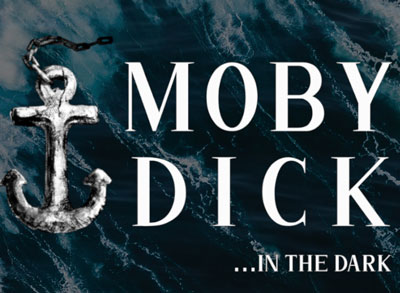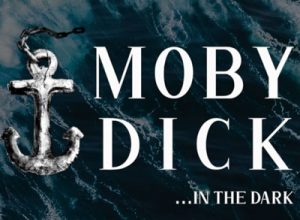
 **** Highly Recommended Brilliantly adapted from the novel by Herman Melville, “Moby Dick in the Dark” is a treat for fans of old-time radio. Director and adapter Corey Bradberry has abridged a 600-page classic into a 90-minute marvel of audio-only entertainment on Zoom, with much of the script rewritten in iambic pentameter. Because this is a live production (i.e., not a recorded one), the challenges are many. Lots of rehearsals were needed for the group to bond together not just to get the timing down between remote locations (Chicago, Vancouver, and New Orleans) but to ensure crisp transitions between the characters. In the story Moby-Dick, people from different places come together onboard ship to go after a whale. In “Moby Dick in the Dark”, people from different places come together online to present a whale of a story.
**** Highly Recommended Brilliantly adapted from the novel by Herman Melville, “Moby Dick in the Dark” is a treat for fans of old-time radio. Director and adapter Corey Bradberry has abridged a 600-page classic into a 90-minute marvel of audio-only entertainment on Zoom, with much of the script rewritten in iambic pentameter. Because this is a live production (i.e., not a recorded one), the challenges are many. Lots of rehearsals were needed for the group to bond together not just to get the timing down between remote locations (Chicago, Vancouver, and New Orleans) but to ensure crisp transitions between the characters. In the story Moby-Dick, people from different places come together onboard ship to go after a whale. In “Moby Dick in the Dark”, people from different places come together online to present a whale of a story.
Although Melville’s original text contains many characters, they have been largely distilled into four: Ishmael (Elizabeth McCoy), Captain Ahab (Robinson J. Cyprian), Starbuck (Mack Gordon), and Stubb (Mack Gordon). Throughout the performance, Bradberry serves as stage manager and reads the settings for various scenes. The performers do a marvelous job modulating their voices and doing accents in order to play a number of distinct characters; it is amazing to hear how their timbre mixes perfectly. With COVID, each of them had to turn a closet in their homes into a soundproof booth and double as foley artists, experimenting with sound effects. Original music by Nick Montopoli was forceful and expressive, adding to the intensity of the action and playing up the dramatic elements within the text. With only the script to work with and no visuals, Montopoli found writing the music to be a “superinspiring” challenge. Prerecorded hymns and sea shanties sung by the cast round out the sound.
Following directions, I found a cozy, dark space in my room and sat back and enjoyed my favorite brand of grog, the suggested alcoholic drink of the day. Then I listened to how all the intricate components of this live show came together in real time. It is best to let the adventure overtake you, so that you can use your imagination to conjure up the Pequod, an 86-foot whaling ship with a crew of thirty, leave its port and head for the open sea. And of course, we can imagine Moby-Dick, a 60-foot white sperm whale with its heavenly color, hellish teeth, and penetrating and suspicious eyes: a god among sea creatures in the Atlantic Ocean. Then too, we can see in our mind’s eye the hustle-bustle of the whaling industry in mid-nineteenth century Nantucket, where whaling was a treacherous and physically taxing occupation but worth the financial reward. This was a time when the commercial uses of whale oil and sperm oil for lighting lamps was extremely lucrative before the use of kerosene became the norm.* In addition, whalebone, or baleen, was used in making women’s corsets as well as buggy whips, parasol ribs, switches, crinoline petticoats, and collar stiffeners. But Captain Ahab doggedly chooses to go after the big white whale not out of expectations for financial gain or the adventure of the hunt but instead out of revenge: for the fact that the creature had bit off half his leg during a previous sea voyage. The question, then, is what makes Captain Ahab’s vendetta a viable motivation for stalking Moby-Dick when, in fact, this animal only did what was in its nature? Is this reason enough to put himself at risk and the lives of so many others?
Good storytelling is a tradition that goes back thousands of years to our cultural roots, and this production is only the latest permutation of where the theatre of the mind can take us. While reading Melville’s original may make us reflect more deeply on philosophical questions such as the role of predestination and free will—and questions about why God made whales in the first place—the adapted script is more barebones. Bradberry boiled the story of Moby-Dick down to its essence: predominantly an action-adventure which is infused with some measure of autobiography and survivor’s guilt. Though it would be best to have some basic familiarity with the story in advance, the show can be followed remarkably well as it stands now. In sum, crisp dialogue, rhythmic prose, and atmospheric music and sound effects are integrated superbly in the course of retelling this classic tale.
“Moby Dick in the Dark” is being streamed live online through April 10, 2021.
Performances are:
Thursdays through Saturdays at 8:00 p.m. CT
Sundays at 7:00 p.m. CT
Wednesday, April 7th at 10:00 p.m. CT
All Tickets are Pay-What-You-Can ($20-30 Recommended) and are on sale now.
For more information or to purchase tickets, please visit www.theatreinthedark.com.
Phone for information only (no ticketing): 312-285-0314.
*Note from Wikipedia: “In 1846 Abraham Pineo Gesner invented a substitute for whale oil for lighting, distilled from coal. Later made from petroleum, kerosene became a popular lighting fuel. Modern and most popular versions of the kerosene lamp were later constructed by Polish inventor and pharmacist Ignacy Łukasiewicz, in Lviv in 1853. It was a significant improvement over lamps designed to burn vegetable or sperm oil.” Thus the whaling industry was eventually destined to disappear once its main products—whale oil and sperm oil—were no longer commercially viable.
To see what others are saying, visit www.theatreinchicago.com, go to Review Round-Up and click at “Moby Dick in the Dark”.






More Stories
“The S Paradox” reviewed by Julia W. Rath
“A Year With Frog and Toad”
” Monsieur Chopin” a play with music